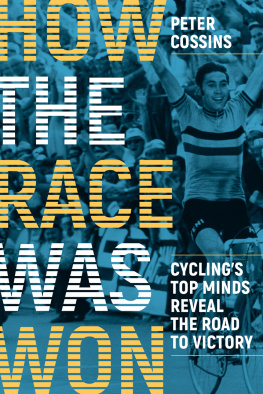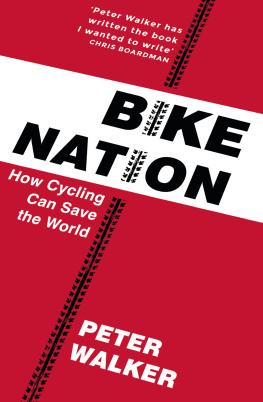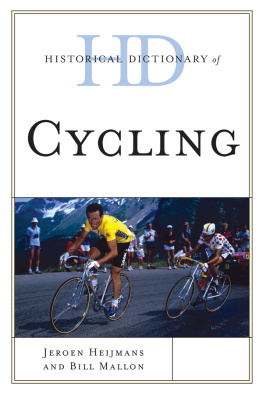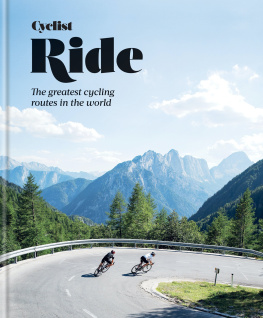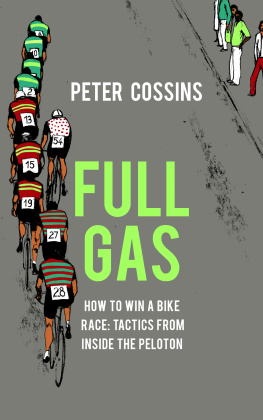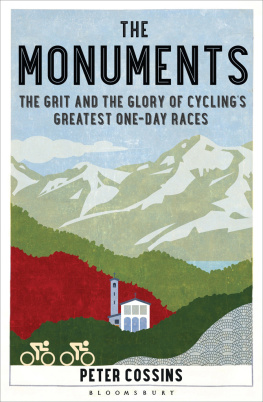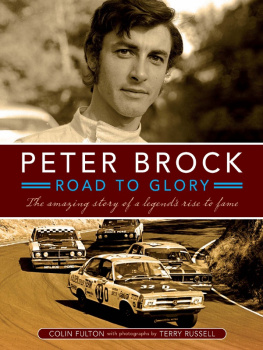Peter Cossins - How the Race Was Won: Cycling’s Top Minds Reveal the Road to Victory
Here you can read online Peter Cossins - How the Race Was Won: Cycling’s Top Minds Reveal the Road to Victory full text of the book (entire story) in english for free. Download pdf and epub, get meaning, cover and reviews about this ebook. year: 2018, publisher: VeloPress, genre: History. Description of the work, (preface) as well as reviews are available. Best literature library LitArk.com created for fans of good reading and offers a wide selection of genres:
Romance novel
Science fiction
Adventure
Detective
Science
History
Home and family
Prose
Art
Politics
Computer
Non-fiction
Religion
Business
Children
Humor
Choose a favorite category and find really read worthwhile books. Enjoy immersion in the world of imagination, feel the emotions of the characters or learn something new for yourself, make an fascinating discovery.
- Book:How the Race Was Won: Cycling’s Top Minds Reveal the Road to Victory
- Author:
- Publisher:VeloPress
- Genre:
- Year:2018
- Rating:3 / 5
- Favourites:Add to favourites
- Your mark:
- 60
- 1
- 2
- 3
- 4
- 5
How the Race Was Won: Cycling’s Top Minds Reveal the Road to Victory: summary, description and annotation
We offer to read an annotation, description, summary or preface (depends on what the author of the book "How the Race Was Won: Cycling’s Top Minds Reveal the Road to Victory" wrote himself). If you haven't found the necessary information about the book — write in the comments, we will try to find it.
Peter Cossins: author's other books
Who wrote How the Race Was Won: Cycling’s Top Minds Reveal the Road to Victory? Find out the surname, the name of the author of the book and a list of all author's works by series.
How the Race Was Won: Cycling’s Top Minds Reveal the Road to Victory — read online for free the complete book (whole text) full work
Below is the text of the book, divided by pages. System saving the place of the last page read, allows you to conveniently read the book "How the Race Was Won: Cycling’s Top Minds Reveal the Road to Victory" online for free, without having to search again every time where you left off. Put a bookmark, and you can go to the page where you finished reading at any time.
Font size:
Interval:
Bookmark:


Copyright 2018 by Peter Cossins
First published in 2018 by Yellow Jersey, an imprint of Vintage.
Vintage is part of the Penguin Random House group of companies.
All rights reserved. Published in the United States of America by VeloPress, a division of Competitor Group, Inc.

3002 Sterling Circle, Suite 100
Boulder, CO 803012338 USA
VeloPress is the leading publisher of books on endurance sports and is a division of Pocket Outdoor Media. Focused on cycling, triathlon, running, swimming, and nutrition/diet, VeloPress books help athletes achieve their goals of going faster and farther. Preview books and contact us at velopress.com.
Distributed in the United States and Canada by Ingram Publisher Services
A Cataloging-in-Publication record for this book is available from the Library of Congress.
ISBN 978-1-937715-86-1; eISBN 978-1-948006-07-1
Cover design by Kevin Roberson
Front cover photo by Jeff Clark
Author photo by Simon Wilkinson
v. 3.1
CONTENTS

To Anabel Hernndez,
an inspiration as a journalist and writer

Cycling is a living, breathing art.
Those cyclists who forget that are halfway to becoming sloth.
Laurent Fignon, We Were Young and Carefree
Its late on a baking mid-August afternoon in the French city of Nmes, which is hosting the start of the 2017 Vuelta a Espaa. Team buses and trucks are lined out beneath the trees flanking the citys main boulevard on the western side of the old town, famed for its Roman amphitheater. Next to some, mechanics are carrying out final checks on equipment, while others provide shelter for riders warming up on stationary turbo trainers for the team time trial that will provide the first test at what is one of cyclings three Grand Tours, alongside the Giro dItalia and the Tour de France.
With the final reconnaissance of the route already done and an hour until the start, theres not much for team directors to do except soak up the sun of southern France. Wandering through the crowds, I spot Patrick Lefevere sitting in a deck chair doing exactly this outside the bus of the Quick-Step Floors team he has managed under different sponsors for almost thirty years. The silver-haired Belgian is famed for his tactical acuity.
Excuse me, Patrick. Do you mind if I ask you a few questions?
What about?
Im writing a book about tactics in cycling...
Hah! Good luck!
Lefeveres booming voice, as deep but not as sonorous as that of Johnny Cash, almost knocks me back and draws the attention of the Quick-Step mechanics and soigneurs, who turn and stare. What have I done to provoke their boss? theyre wondering. And Im thinking the same.
Lefevere pulls off his mirrored shades and looks at me for a few moments, his stare as glaring as the sun. He then points to his right, toward the bike stands and pressure washers where his mechanics have been working.
See that chair over there? Bring it over here next to me. Lets talk...

Bike racing has been described by writer Owen Mulholland as chess at 150 heartbeats a minute, the depiction neatly combining the strategic complexity of trying to outwit 200 other riders when the messages your brain is receiving from every part of your body are telling it slow down! Yet, talk to the riders who battle each other within the peloton, that wonderfully seething mass of mayhem that is so mesmerizing when seen from the TV helicopters, and to the team directors who are lined up in a convoy behind them, and the comparison is more often made to poker. Bike racing is all about bluffing, about hiding what youve got in your legs and what card your team is planning to play, about alliances that come together in an instant and are dissolved just as quickly, about keeping your rivals guessing. In the Netherlands, long one of cyclings heartlands, they have a saying that encapsulates it perfectly: First eat whats on your neighbors plate, then start on your own plate.
Fundamentally, road racing is a very simple sport. Once the riders are waved away, there are essentially just three different scenarios that can be acted out: a small group of riders escapes and ends up deciding the days spoils between them; that small group is reeled in before the finish and the best sprinters in the bunch fight for the win; or, in mountainous terrain, the break goes clear but is chased by the teams of the strongest riders, who then dispute the finish between them on a climb.
Its complexity derives from each of as many as 22 teams beginning the race with a specific strategic objective, which might be as straightforward as ensuring one of their riders gets in that break, or more far-reaching with the stage victory or the leaders jersey as their ultimate goal. Once the race referee has signaled the start of racing, the 22 tactical plans, which will have been agreed on just a few minutes earlier at the briefings held behind the tinted windows of luxury team buses, start to agitate each other like water molecules bouncing around a saucepan over a flame. That there will be a result is inevitable. But what happens between the start flag and the finish-line banner cannot be predicted and can be totally incomprehensible, especially to the occasional fan but even to someone like me who has spent a quarter of a century watching and writing about bike racing.
In an attempt to better understand and explain the constantly evolving and frequently quite exquisite tactical puzzles that every bike race sets and every rider within it contributes to, Ive spent a season watching races with a different perspective, focusing more on the various processes that lead to a rider winning a race, and less on the finale and the words and personality of the winner. It has been enlightening and captivating. In doing so, Ive fallen in love again with the sport that drew me in during the early 1980s, and much more passionately than before. Indeed, I confess that Ive discovered the full scope of its beauty for the first time.
The result is How the Race Was Won, an explanation of the how and why of bike tactics. It delves into the sports history to understand where tactical thinking began and to highlight its development over more than a century. But more than anything, How the Race Was Won is an experts guide into the intricacies of top-level bike racing in the modern era and the tactics that are its essence and that provide so much of its color. The expertise is not mine but comes entirely from those who know bike racing from the insidethe racers and team directors. I am extremely grateful to each and every one of them.

Ally MacLeod thinks that tactics are a new kind of mint.
Billy Connolly
Before getting too deeply into the subject of cycling tactics and how they have developed, a more fundamental question needs to be tackled: Do they actually exist? To be precise, are tactics any more than a riders instinctive reaction to what is happening around them, a response that is impulsive rather than planned?
Next pageFont size:
Interval:
Bookmark:
Similar books «How the Race Was Won: Cycling’s Top Minds Reveal the Road to Victory»
Look at similar books to How the Race Was Won: Cycling’s Top Minds Reveal the Road to Victory. We have selected literature similar in name and meaning in the hope of providing readers with more options to find new, interesting, not yet read works.
Discussion, reviews of the book How the Race Was Won: Cycling’s Top Minds Reveal the Road to Victory and just readers' own opinions. Leave your comments, write what you think about the work, its meaning or the main characters. Specify what exactly you liked and what you didn't like, and why you think so.

